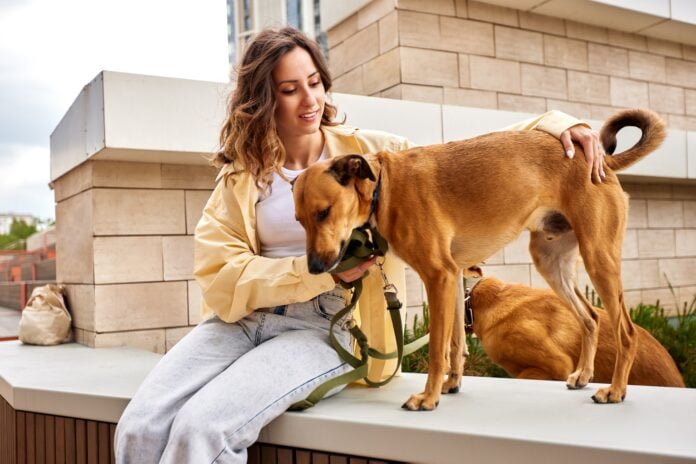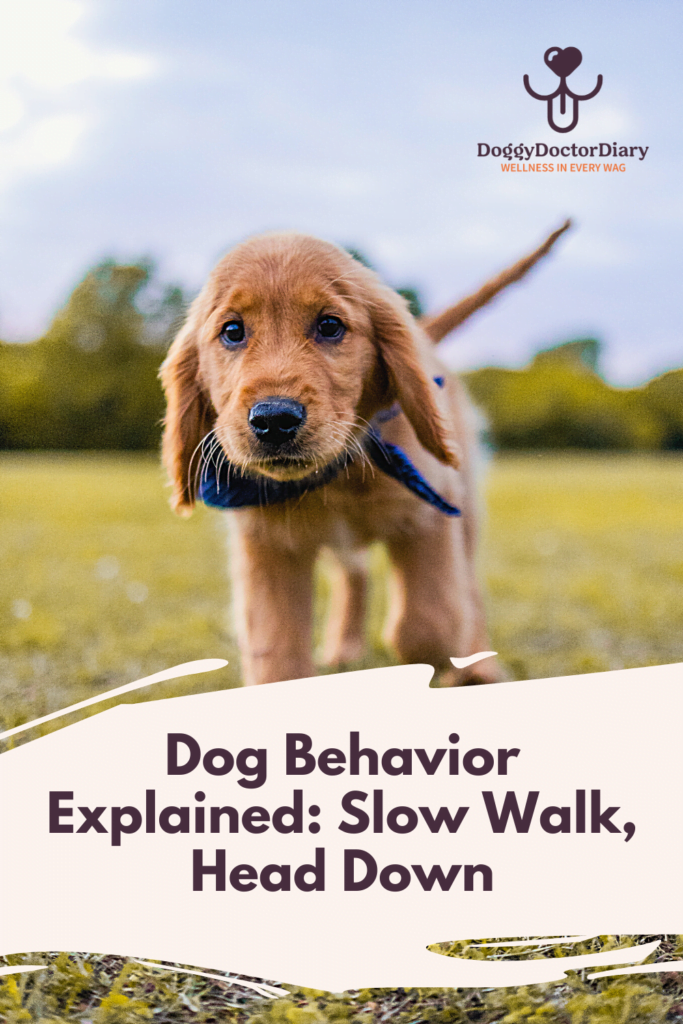

Observing your furry companion take each step with an unusual slowness, tail drooping, and their head hung low can evoke a mix of concern and curiosity. The question many dog lovers have, “Why my dog is walking slow with head down?”, isn’t just a fleeting wonder; it’s a quest for understanding, a desire to ensure their pet’s well-being. In this guide, we’ll journey together through expert insights, shedding light on this behavior.
With a friendly nudge, professional guidance, and a hearty dose of empathy, we aim to answer your burning questions and unravel the mystery behind your dog’s actions. So, if your heartstrings tug every time your pup displays this peculiar pace, gear up for some enlightening discoveries. And as we delve deeper into the world of doggy behavior, rest assured, the revelations will be both heartwarming and enlightening.
First Things First: Understanding Doggy Behavior
Before diving deep into the reasons behind a slow, head-down walk, it’s essential to grasp the basics of doggy behavior. Dogs, much like us, communicate volumes through subtle actions and emotions. Whether it’s joy, pain, or curiosity, every move has a story.
If you’re interested in more training tips and insights, explore our guide on Unlock Bubble Theory Dog Training: Proven Success Tips!.
The Emotional Lives of Dogs
Dogs aren’t just tail-wagging furballs; they’re bundles of feelings. Every jump, bark, or wag is a reflection of their inner emotions. Whether it’s a cheerful play or a sulky afternoon, understanding these emotions can be the key to unlocking their behavior.
Observing the Physical Nuances in Their Walk
Beyond emotions, a dog’s walk is a silent narrative. Just as we might drag our feet after a long day or strut confidently into a room, dogs use their gait to speak. Observing these physical nuances can offer clues about what’s going on inside.
Now, having gained some insights into the fundamentals of our four-legged friends’ behavior, let’s move on to explore the specific reasons that might be causing that unusual pace in your dog.
Reasons Your Dog May be Walking Slow with Head Down
When our furry companions adopt a slower, head-down pace, a whirlwind of concerns can flood our minds. From health to emotional challenges, several factors could be at play. Let’s break down the possible culprits.
Physical Pain and Ailments
Dogs can’t tell us when they’re hurting, but their behavior surely can. Physical pain is a primary reason for changes in their walking patterns.
Arthritis: A Common Old Age Ailment
Just as folks can get creaky knees and achy backs, our four-legged pals can also suffer from arthritis. As they age, the wear and tear on their joints can lead to discomfort, causing that slow walk you’re witnessing.
Neurological Diseases
A change in gait could hint at underlying neurological issues. Conditions like degenerative myelopathy or intervertebral disc disease can influence their mobility, often resulting in a cautious walk.
Ear Infections and Vestibular Issues


Dogs rely heavily on their ears for balance. An ear infection or a vestibular disorder might throw off their equilibrium, making them walk with their heads lowered to navigate better.
Emotional Triggers
Much like us, dogs are emotional beings, and sometimes, the weight of their feelings can affect their stride.
Anxiety and Stressors
A stressful environment or event can cause anxiety in dogs. An anxious pup might walk slowly, with its head down, as a protective response to feeling vulnerable.
Behavioral Shifts
Changes in their usual environment or routine can lead to behavioral adjustments. The slow walk might be their way of cautiously processing the newness or change.
Signals of Submission
In doggy language, a lowered head can be a sign of submission, especially when interacting with other dogs or alpha figures in their lives.
Environmental Causes
The world around them, with its myriad of stimuli, plays a significant role in shaping their behavior.
Being in Unfamiliar Territories
A new environment can be overwhelming for some dogs. They might walk slowly, taking everything in, while trying to find familiar cues.
Responses to Scents and Smells
Dogs have a keen sense of smell, and sometimes, a particular scent can grab their attention, making them slow down and focus.
Avoidance Behavior from Punishments or Fear
Past negative experiences, like scolding or physical punishment, can result in dogs walking carefully, with their heads down, to avoid drawing attention.
Having unraveled these potential causes, it’s crucial to differentiate between a simple slow walk and more concerning behaviors. Let’s move on to delve deeper into distinguishing these patterns.
Spotting the Signs: Differentiating Slow Walking from Other Behaviors
Deciphering dog behavior can feel like assembling a jigsaw puzzle. When you notice “my dog is walking slow with head down,” it might appear clear-cut. Yet, it’s crucial to observe other signs alongside this behavior to truly understand the whole story.
Staggering, Shaking, and Panting
Each dog is unique, but staggering, shaking, and panting alongside a slow walk might raise more red flags than a leisurely stroll in the park. These symptoms combined can indicate more severe underlying issues, from heat stroke to neurological disorders.
When to be Concerned
If you’ve got a pup displaying these behaviors consistently, or if they appear suddenly in an intense bout, it’s no longer just about the slow walk. That’s when the alarm bells should ring.
Seeking Timely Interventions
Time is of the essence. Much like you wouldn’t wait to treat a limp, don’t procrastinate when it comes to these signs. Early intervention can make all the difference in diagnosis and treatment.
Alright, now that we’ve got the warning signs down pat, it’s time to delve into some expert-backed solutions. Let’s move on to ensure our furry friends remain in tip-top shape.
Expert Advice and Solutions
When your fur baby’s well-being is on the line, skimming over advice won’t cut it. Tapping into expert knowledge is paramount, ensuring you’re equipped with solid solutions that resonate with your dog’s needs.
My Dog is Walking Slow with Head Down: Why a Vet Consultation is Crucial
No amount of googling can substitute for a veterinarian’s expertise. A slow walk might seem minor, but underlying causes can range from mild to severe. So, before you jump into DIY treatments, consulting a vet is a no-brainer. They’ve got the know-how, tools, and keen eye to pinpoint what’s going on, providing peace of mind.
Calming Techniques for Anxiety and Stress
Ah, stress—it’s not just a human thing. Our four-legged pals can get overwhelmed too.
Calming Collars and Their Benefits
Dogs can be more perceptive than we give them credit for. Calming collars release pheromones similar to those a mother dog produces, offering a soothing embrace without the need for oral meds. It’s a simple, non-invasive method to ease your pup’s jitters.
Creating a Stress-Free Environment
Home should be a haven, not just for you but for your furry buddy as well. Soft music, a comfy resting place, and regular routines can turn your space into a serene oasis, warding off anxiety triggers.
Alright, equipped with expert advice, let’s move on and dive into some heartfelt stories and insights shared by fellow dog enthusiasts.
Voices of Fellow Dog Lovers
Ever heard the saying, “It takes a village”? Well, the dog-loving community is exactly that – a village of passionate individuals who’ve been down similar roads with their canine companions.


Personal Experiences and Anecdotes
From the East Coast, Jenna shares her distressing experience when her Golden Retriever, Boomer, started exhibiting the troubling signs of “my dog is walking slow with head down.” That summer, after multiple trips to the vet, Boomer was diagnosed with arthritis. Jenna confesses, “I was completely unaware.” The sight of him struggling was heartbreaking. Fortunately, with the right medication and care, Boomer bounced back to his lively self!
Practical Tips and Advice
Mike, a proud Bulldog dad, shares, “The first time I saw Daisy walking slow with her head down, I panicked. Turns out, she just wasn’t a fan of the new park. Knowing your dog’s habits and dislikes can be a game-changer.”
Such stories underline the importance of community and shared wisdom. They remind us we’re never alone in our canine journeys. So, as we continue to unpack this topic, let’s move on and address some of those pressing questions you might have.
FAQs: Answering Your Burning Questions
Alright, let’s dive straight into those questions that have been gnawing at your noggin. It’s always good to be in the know, especially when it comes to our furry pals.
Why my dog is suddenly walking slowly?
Several reasons can contribute to this change, ranging from physical pain like parvo to emotional distress due to anxiety. Regular check-ups can help pinpoint the cause.
Could a slow walk indicate serious health issues?
While not always the case, a sudden change in walking pace may be a symptom of underlying issues such as neurological diseases or infections. It’s vital to consult with a vet.
How do I differentiate between physical pain and emotional triggers?
Physical pain often has visible signs like limping, while emotional triggers may cause behavioral shifts, like hiding or tail tucking. Observing your dog’s overall demeanor can provide clues.
What should I do if I notice my dog walking slow with its head down?
Firstly, don’t panic. Monitor their behavior and look for any other symptoms. If the behavior persists, schedule a vet visit.
Are there any home remedies for slow walking due to old age?
While there’s no substitute for professional advice, gentle exercises, warm compresses, and certain supplements might help older dogs. Always consult a vet before making any changes.
Knowledge is power, my friends. And now that we’re a bit more enlightened, let’s move on to tying everything together and looking at the bigger picture when it comes to our loyal companions.
Wrapping It Up: Ensuring Your Dog’s Health and Happiness
As we draw to a close on our deep dive into “my dog is walking slow with head down,” it’s evident how much we all cherish our canine companions. Their well-being is paramount to us. So, how can we make certain they’re always gleaming with tail-wagging joy?
Tips for a Healthy Dog Lifestyle
Promote an active life with regular walks and playtime. Ensure a balanced diet, and don’t skimp on those annual vet check-ups. Remember, a little preventive care can go a long way in keeping those puppy eyes shining bright.
Staying connected and observant: Your role as a loving owner
Being a dog owner isn’t just about feeding and walks; it’s about building a bond. Take time to understand your furry pal, noticing any changes in behavior or habits. Your attention can make a world of difference in their lives.
In the grand scheme of things, our dogs offer us unconditional love, wagging tails, and an abundance of wet-nosed kisses. Giving them a life filled with love, health, and happiness is the least we can do in return. Thanks for joining us on this journey of understanding and care. Stay pawsitive and keep loving those pups!


















[…] Why My Dog is Walking Slow with Head Down? Expert Insights […]